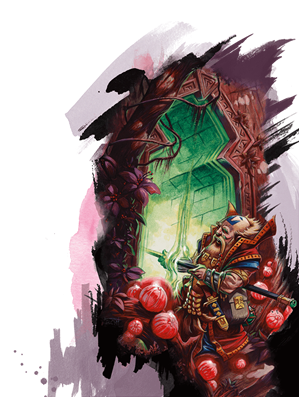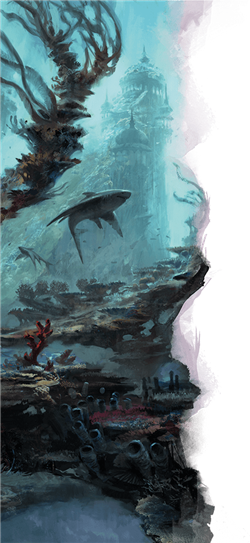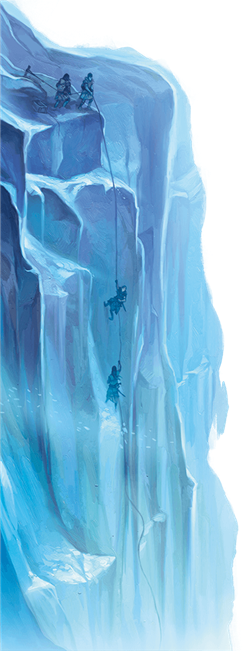Designing the Dungeon: Terrain
“Master Darkstar,” the goblin said, bowing his head as he entered his master’s audience chamber. “My sappers have breached the dwarven stronghold. It’s empty, just as you divined.”
“Excellent.” The drow smirked. He reclined languidly in his throne, draping his slim frame sideways across it and dangling his legs off of one the seat’s arms. “Then much of our work is already done for us. The dungeon is broken up into neat little rooms—perfect, bite-sized challenges to tax those meddling adventurers before they reach my sanctum. You have done well, my minion.”
The goblin smiled and clasped his hands. “By your leave, master. I’ll get my team to work the stone of the connecting caves to match the stronghold’s dwarven architecture.”
“Hold, servant. One thing more!” the drow exclaimed, wearily raising one finger into the air. The goblins ears drooped in dismay.
“And what is this... one thing, Your Malevolence?”
“Your masons will not rework the walls of the caves. No, they will take their hammers and chisels to the dwarven walls and hew them apart. Smash them until they are as rough as the natural stone outside. Make them match down to the very pockmarks of erosion.” The drow smiled a wide, toothy grin and learned his head back against the arm of throne.
“What?” stammered the goblin, wringing his hands. He gnashed his teeth and scraped his toenails against the ground. “Reworking the dwarven walls will take weeks... months! Why? I beg your patience—why!?”
“Aesthetics!” the drow exclaimed, spreading his manicured hands wide. He leapt onto his throne and landed in a squat, peering directly into the goblin’s lamp-like yellow eyes. “My dear servant, aesthetics are everything! Will the adventurers expect ancient dwarven traps in cave-stone? No! They won’t think for a minute that dwarven defense automata will be lurking within a natural alcove. And when they get wise and examine the walls, only to see the tell-tale marks of goblin chisels? Imagine the look of dawning comprehension on their faces—the pallor of fury, tempered with awe and admiration for my sheer genius! This is my masterstroke!”
“Uh, yes, my master. Thy will be done.”
 Next Sunday, my players will be venturing into a series of underground caverns in search of a secret entrance into an evil warlock’s fortress within a hollow mountain. Supernatural earthquakes have transformed the foothills surrounding the mountain into a lifeless wasteland of jagged rocks and deep fissures. These same earthquakes have created a labyrinth of lightless caverns below the foothills, and they have been further sculpted into a treacherous dungeon by magic spells and the claws and fangs of burrowing monsters.
Next Sunday, my players will be venturing into a series of underground caverns in search of a secret entrance into an evil warlock’s fortress within a hollow mountain. Supernatural earthquakes have transformed the foothills surrounding the mountain into a lifeless wasteland of jagged rocks and deep fissures. These same earthquakes have created a labyrinth of lightless caverns below the foothills, and they have been further sculpted into a treacherous dungeon by magic spells and the claws and fangs of burrowing monsters.
I’m going to play this dungeon completely straight. The players’ innate expectations of what they will find in a natural cave system will probably be correct, and it will allow them to engage in a fairly straightforward dungeon crawl, unhindered by second-guessing and self-doubt. This will ideally cultivate forward momentum, leading them towards an exciting climax of this arc. If I wanted them to proceed with caution and be filled with fear and dread, I would defy their expectations by intentionally presenting them dissonant elements like normal, everyday humanoids wandering around in this dangerous cavern. Maybe then I would cash in on their confusion and surprise by revealing that these “normal” humans are actually a hive of elder oblex assuming human form!
I won’t do that, but expectations have incredible power in dungeon design. Setting, or as we’ll describe it in this article, “terrain,” is one of the greatest creators of expectations in gaming. Your dungeon’s terrain instantly communicates volumes about the content and tone of your dungeon. Best of all, it’s all implicit. Even using the same base material, stone, the way it’s presented can speak volumes: a natural cavern communicates something completely different from the worked stone of a subterranean dwarven fortress, which in turn is different from the ribbed tunnels of a purple worm burrow.
Expectations allow you to create shorthand, or easily communicable pieces of incomplete information that cause your players’ minds to fill in the blanks. It’s a sort of cognitive autocorrect, which we can use to either make our dungeons more efficient at communicating ideas or tone, or deliberately use shorthand to defy expectations and surprise players.
Dungeon terrain is shorthand. We don’t want to spend hours describing every minute detail of a dungeon room, so we paint in broad strokes that evoke images that draw upon our players’ past lived experiences or cultural touchstones. Each one of the above dungeon terrains latches onto the players’ emotional biases and media knowledge. Fantasy gaming veterans know that cleanly worked stone walls means that someone has purposefully constructed a location, and that it can contain traps, secret doors, and maybe even ancient enchantments. Well-crafted stonework can serve as shorthand for civilization—typically an ancient civilization, which conjures the sense of wonder of exploring an ancient tomb in Indiana Jones, the majesty of seeing the lost glory of the Dwemer ruins of Skyrim, and the anticipation of uncovering forbidden knowledge in the Chamber of Secrets from Harry Potter. On the other hand, natural caves are associated with the chaos of nature and beasts, like the shock of seeing a cloud of bats emerging from a massive sinkhole, the tension of trying not to awaken a hibernating bear in its cave, or the fear of hearing Gollum singing to himself on his island in The Hobbit.
Playing it Straight: When Your Terrain Meets Expectations
 Amateur authors overvalue originality. When I DMed one of my first-ever campaigns, I tried to throw my players for a loop by creating all new fantasy races, new magic systems, and a story that twisted and turned like a non-OSHA-compliant roller coaster. It didn’t work. It just confused my players and made me frustrated that they didn’t “get” my vision. My next campaign hewed closer to traditional fantasy, and my players “got it” instantly, and we had a great time.
Amateur authors overvalue originality. When I DMed one of my first-ever campaigns, I tried to throw my players for a loop by creating all new fantasy races, new magic systems, and a story that twisted and turned like a non-OSHA-compliant roller coaster. It didn’t work. It just confused my players and made me frustrated that they didn’t “get” my vision. My next campaign hewed closer to traditional fantasy, and my players “got it” instantly, and we had a great time.
This isn’t an argument against being creative, but there are two things you have to know about uniqueness in fantasy, and the first thing is that the more unusual your dungeon is—or your story, your society, your creature, etc.—the more you have to explain to your audience. And in this case, your audience is your players. Using concepts that your players are familiar with, that is to say shorthand, speeds up your game by cutting down on exposition and makes your fantasy feel more natural.
Your job as a Dungeon Master is not just to be creative, but to be creative with purpose and with clarity. Your players are your audience, but they are simultaneously your fellow authors. When you create something, be it a dungeon or otherwise, your foremost goal must be to impart crucial information to your collaborators. Just like when we designed your first dungeon together, information can be broken down into Who [lives here], What [created it], Where [in the world is it], When [was it created], and Why [was it created]. How [was it created] is also useful when it comes to describing locations. The trick is not overloading your players with all of this information. Unloading it all onto them in an exposition dump is a great way to bring your game to a dead stop and bore your players to tears. That’s where shorthand comes in.
Shorthand lets your players assume a lot of this information. If you present them with a familiar location that fits with their preconceived genre expectations, you only need to make explicit the stuff that breaks those expectations. My genre expectations are rooted in Western culture and fantasy fiction, so while they aren’t universally applicable, they should be familiar to American gamers, at least. Here’s some examples of information that specific dungeon terrains can convey implicitly to players:
Natural Cave
- Who: Beasts like bats and bears. If very deep, Underdark humanoids like drow, duergar, and illithids.
- What: Erosion, natural forces, possibly wild magic
- Where: Underground
- When: Thousands or millions of years ago
- Why: n/a
- How: [same as What, in this case]
Worked Stone, Dwarven Architecture
- Who: If in ruins: cave-dwelling creatures, underground monstrosities like ropers, duergar, ancient constructs, demons in summoning circles, dragons on heaps of gold
- What: Dwarves or duergar, possibly working the walls of existing natural caverns
- Where: Underground or the Underdark, possibly connected to a structure on the surface
- When: Within human living memory, within dwarven living memory, or thousands of years ago
- Why: To defend against invaders
- How: Using physical tools and laborers, or magic and wizards
From these two examples, you can already see that some player assumptions are more useful than others. Is your group usually more interested in a location’s original purpose (Why) or in its current inhabitants (Who)? Both are important, but figuring out which of these elements speak to your group will allow you to tailor your dungeons and even entire adventures to their preferences. Knowing which elements excite you the most is important, too! Don’t forget that the Dungeon Master needs to have fun while playing.
Throwing a Curveball: When Your Terrain Defies Expectations
 Part of the fun of Dungeon Mastering is coming up with concepts that are totally unique to your campaign. We’ve all heard of a red dragon living in a volcano, but what about a red dragon living in the heart of a glacier? This scenario instantly presents questions and creates a less straightforward dungeon experience, which you can utilize to instill doubt or deliberate slow the pace of play, if deployed strategically.
Part of the fun of Dungeon Mastering is coming up with concepts that are totally unique to your campaign. We’ve all heard of a red dragon living in a volcano, but what about a red dragon living in the heart of a glacier? This scenario instantly presents questions and creates a less straightforward dungeon experience, which you can utilize to instill doubt or deliberate slow the pace of play, if deployed strategically.
This scenario—juxtaposing opposites by placing a creature of fire in a location of ice—is high fantasy to the core, but it might be too much. If your players are exploring this glacier expecting to fight a frost giant, a remorhaz, or a white dragon, they will certainly be surprised to see a red dragon lairing in the heart of the dungeon!
This surprise could be a memorable shock—but it could also break their suspension of disbelief. People are willing to suspend disbelief a lot in fantasy, but this suspension of disbelief is a form of social contract. You can successfully amend this contract by slowly adding “out there” elements, but throwing in something like a red dragon in a glacier without any foreshadowing? Some players would feel cheated, especially if they spent a lot of their game resources on frost resistance or giant-slaying weapons.
One way to temper this surprise is to be upfront with it. If you present the places where your terrain differs from your players expectations when they enter the dungeon (or even before they enter it), then you still gain the benefit of putting them off-balance, but don’t risk completely upending the apple cart. This may require you to use that most maligned of all writers’ devices: exposition—but if it saves you time in the long run, exposition can be a useful tool. Sometimes simply having a quest-giver say “A red dragon lives in the heart of that glacier!” sets the tone for an entire adventure, and will have your characters hunting for strange fire-and-ice traps and monsters throughout the whole dungeon.
Finally, giving away your twist monster before the dungeon even begins has the benefit of switching the focus away from the fairly mundane question of who [lives in the dungeon?] to the meatier mysteries of why [is it there?] and what [is it doing?]. Both of these questions will have your players searching for answers that dig into your creatures’ motivations and goals, rather than the surface-level inquiry of “what monster will we be fighting next?”
Have you ever thought about how terrain impacts the way your players approach your dungeon? Have you ever used this to your advantage? Let us know in the comments!
 James Haeck is the lead writer for D&D Beyond, the co-author of Waterdeep: Dragon Heist and the Critical Role Tal'Dorei Campaign Setting, and is also a freelance writer for Wizards of the Coast, the D&D Adventurers League, and Kobold Press. He lives in Seattle, Washington with his partner Hannah and two fuzzy dungeon-dwellers, Mei and Marzipan. You can usually find him wasting time on Twitter at @jamesjhaeck.
James Haeck is the lead writer for D&D Beyond, the co-author of Waterdeep: Dragon Heist and the Critical Role Tal'Dorei Campaign Setting, and is also a freelance writer for Wizards of the Coast, the D&D Adventurers League, and Kobold Press. He lives in Seattle, Washington with his partner Hannah and two fuzzy dungeon-dwellers, Mei and Marzipan. You can usually find him wasting time on Twitter at @jamesjhaeck.

-
View User Profile
-
Send Message
Posted Jun 27, 2018I don't know what those "[Tooltip Not Found]" creatures are but they seem pretty damn dangerous and they can shapechange into humans, dang! :D
-
View User Profile
-
Send Message
Posted Jun 27, 2018Oblex having age categories is not something I took into account when tooltipping them today...
-
View User Profile
-
Send Message
Posted Jun 27, 2018most likely doppelgangers
-
View User Profile
-
Send Message
Posted Jun 28, 2018No worries ;) An Elder oblex is indeed a nasty thing to cross paths with...
-
View User Profile
-
Send Message
Posted Jun 28, 2018I kinda liked the mystery of not knowing what you were talking about... was it were-human owlbears? I bet it was owlbears!
-
View User Profile
-
Send Message
Posted Jun 29, 2018Who else loves the Goblin and Darkstar paragraphs?
Great article!
-
View User Profile
-
Send Message
Posted Jul 1, 2018Now if only there was a favoriting system because this will help. A lot.
-
View User Profile
-
Send Message
Posted Jul 8, 2018I think it's that the "make-a-wish"-monster. It's really neat and there was a spotlight-article not long ago. Would have linked you but i didn't found it right away.
-
View User Profile
-
Send Message
Posted Dec 2, 2018i do
-
View User Profile
-
Send Message
Posted Dec 11, 2020For a red dragon in a glacier you could describe the smoothness of the tunnels and add in a natural heat source, such as hot springs or lava.